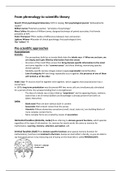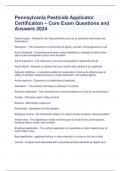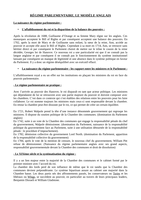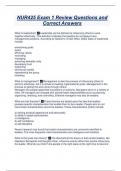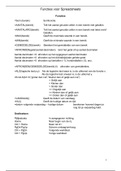From phrenology to scientific theory
Wundt→first psychological laboratory 1879 in Leipzig; first psychological journal “philosophische
studien”
William James→started as painter; “principles of psychology”
Mary Calkins→student of William James; designed technique of paired associates; first female
president of APA
Helen Thompson→first studies of differences between men and women
Lightner Witmer→founder of clinical psychology; first psychological clinic
The “millers”→
Pre-scientific approaches
Associationism
Aristotle:
- Our perceptions build on an innate blank slate-the tabula rasa → When we are born, we
are empty and it gets filled by information from the senses
- Structure of the mind→five senses that bring domain-specific information to the mind
and come together in the “common sense” and there thinking, memorizing operate
domain-general
- Modality-specific sensory images (vision) supply supramodal mental faculties.
- Law of contiguity→if two things repeatedly occur together, the presence of one of them
will remind us of the other
Hebb´s law → neurons that fire together wire together, which suggests that associationism has a
neural basis.
In 1970s long-term potentiation was discovered→if two nerve cells are simultaneously stimulated
for a period of time, the synapse binding them is strengthened.
- The idea of a tabula rasa is later titled as “empiricism” and its opposing theory, nativism,
states that a set of mental abilities and knowledge is already present from birth on
(plato, Descartes).
Locke:
- Blank state→we are born without built-in content
- Sensoristic→all content comes from the senses
- Atomistic→these elementary sensations (smell, visual, taste etc.) are building blocks of
more complex content forms
- More complex forms are created by means of association
Horizontal faculties (Aristotle, Locke)→are referring to domain-general functions, which operate
regardless of the type of information. So, memory for words works the same as memory for
mathematics. Learning, memory, attention, perception, will.
Vertical faculties (Gall)→are domain-specific functions (one special memory function for
mathematics); functions are localized in the brain; bumps on skull reflect a faculty, so you are able to
say how good person is by measuring size of bump on the head (this is called PHRENOLOGY)
,Pseudo-science:
- Physiognomy→on the bases of the face, you can recognize the character of a person
(big forehead, criminal etc.)
- Mesmerism→you can heal people by magnetic forces; use of hypnosis and magnets
during treatment
- Mental healing→healing through correct, positive thinking (the idea of cognitive
therapy)
- Spiritualism→contact with the spirits of the dead (spiritual people have the ability to
bring you into contact with passed people for example)
Neuroanatomy, time and psychophysics
Flourens vs. Gall:
- Flourens wanted to test the ideas of Gall (localizationism)→he experimented with
pigeon and rabbit brains; if functions are specialized and localized, then taking parts
away should have specific effects. He found out that: brainstem lesions lead to loss of
vital functions; cerebellar lesions hinder motor coordination; cerebral cortex lesions
impair higher-level functions.
- Conclusion of Flourens was that gall was wrong and that the whole cortex is involved in
higher mental functions. He found that perception and memory did not correspond to a
specific spot in the brain. Thus, some functions are not localized but distributed.
Flourens could not find specializations in cortex! Thus, some functions are not localized
but distributed (holism).
- However, the subjects were pigeons and rabbits not humans!
Broca´s discovery:
- He discovered that damage to left frontal cortex (Broca´s area) causes speech
production difficulties. So, apparently Flourens was wrong and functions are not all
over the brain, but localized.
Wernicke´s language model:
- Damage to left side in temporal cortex→patients could speak, but comprehension was
impaired
- Main assumptions are that there are motor images in brocas area and auditory image in
wernickes area and these are connected to each other. So, when you hear a word it
activates the auditory image and it can activate the motor image or the concept image
(activating concept image means that you can understand what you hear).
- Thinking about the mind like Aristotle did: sensoristic→all information comes from
senses; atomistic→you combine them by means of association
- Wernicke´s aphasia → comprehension problems caused by damage in Wernicke´s area.
, - He says that motor images and auditory images are localized, but the concept images are
distributed, because they consist of combinations of information→combination between
domain-specific and domain-general.
Speed of nerve impulses:
- Johannes Müller said nerves are infinitely fast, so immeasurable
- Helmholtz measured nerve transmission in frogs (took limb of frog and took out a
muscle, embedding it in an electrical circuity); he stimulated the nerve connected to
muscle ones very close (A) to the muscle and ones further away (B) and he knew the
distance between these two points and measured the contraction time of both (30m/s).
Thereby, he introduce an estimate for a measure of the speed of nerve impulses.
Donders measuring device for the speed of mental processing consisted of a tuning fork, a cylinder
with sooted paper and a receiver for speech. Participants were given the task of repeating words
and the time it took them was then determined.
Donders subtraction method:
- Task A required response as soon as a stimulus was presented and therefore involved
perception and action. Task B required responding via one of several actions as soon as
the corresponding stimulus was presented. Task C required to respond only to a certain
stimulus, involving perception, recognition and action.
- C-A=recognition duration & B-C=choice duration
Sternberg´s additive factors method:
- Extension of his idea with the aim to identify the processing stages rather than
measuring their duration
- You have two factors (clarity low/high & number of choices 2/4). If indeed perception
and choice are different stages, the effects of the manipulation add up (assuming that 2
choices faster than 4 and high clarity faster than low). The effects have no interaction,
but additive effects, if they affect different stages.

